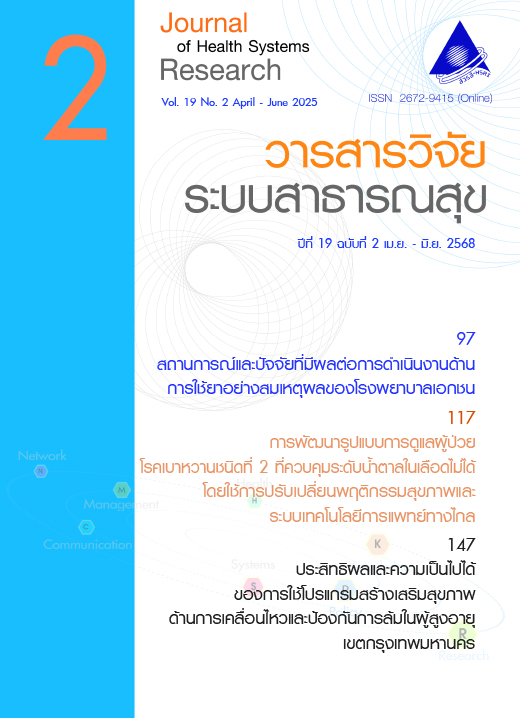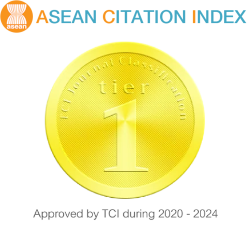Evaluation of the PM2.5 Health Risk Surveillance System in Nong Khai Province, Thailand: A Pilot in Health Region 8
Keywords:
disease surveillance system evaluation, PM2.5 exposure-related diseases, pilot area, Nong Khai province, Health Region 8Abstract
Fine particulate matter (PM2.5) pollution poses a global public health concern. In Thailand, Nong Khai Province, located in the 8th Regional Health, has frequently recorded 24-hour average PM2.5 levels exceeding national standards, often reaching levels that adversely affect health. Major sources of PM2.5 include open burning and transboundary haze, impacting a large segment of the population. This study aimed to evaluate the disease surveillance system for PM2.5 exposure-related diseases in Nong Khai province as a pilot area. A mixed-method research, using quantitative and qualitative approaches, was conducted in 2024, assessing both quantity and quality attributes of the disease surveillance system. The qualitative component included interviews with both executive and operational officers from relevant government agencies in the area between 21 February and 28 June 2024, capturing insights from both leadership and frontline personnel. The quantitative component utilized stratified sampling to collect data from patient medical records, which were then analyzed using descriptive statistics, including frequencies and percentages. Findings from the qualitative study revealed that all 13 interviewed officials (100%) acknowledged the importance of the surveillance system. They found it easy to report and noted its usefulness in disease prevention and control. However, issues such as reporting delays and ambiguities in disease coding guidelines were identified. The system was adaptable, with minimal disruption to routine operations. In the quantitative assessment, 345 medical records were reviewed, with 181 cases matched case definitions. The surveillance system demonstrated 100% sensitivity and a positive predictive value (PPV) of 53.1%. Completeness of data for age, gender, and nationality was 100%, and for ICD-10 codes was 98.8%. Accuracy levels for age, gender, nationality, and ICD-10 coding were 98.0%, 92.5%, 98.3%, and 94.8%, respectively. Data on age, gender, and date of service were considered to be representative. In conclusion, the study highlighted that the disease surveillance system demonstrated strong qualitative adaptability and high sensitivity in quantitative measures, but identified gaps in data accuracy and coding clarity. It is recommended that the system be enhanced with automated, real-time reporting capabilities, directly integrating with hospital HIS systems to reduce errors and improve efficiency. Additionally, the adoption of comprehensive disease coding, including codes like Z58.1 for PM2.5 exposure, is encouraged to strengthen surveillance, prevention, and control efforts.
References
World Health Organization. WHO global air quality guidelines: particulate matter (PM2.5 and PM10), ozone, nitrogen dioxide, sulfur dioxide and carbon monoxide. 1st ed. Geneva: World Health Organization; 2021 [cited 2024 Oct 13]. 278 p. Available from: https://www.who.int/publications/i/item/9789240034228.
Pollution Control Department. Action plan for driving the national agenda on dust pollution management [internet]. Pollution Control Department, Ministry of Natural Resources and Environment; 2019 [cited 2024 Oct 13]. Available from: https://www.pcd.go.th/strategy/แผนปฏิบัติการขับเคลื่อนวาระแห่งชาติ-การแก้ไขปัญหามลพิษด้านฝุ่นละออง/. (in Thai)
Division of Occupational and Environmental Diseases. Sripuang N, Anantakulnatee P, editors. Manual for surveillance, prevention, and control of diseases and health threats caused by particulate matter less than 2.5 Microns (PM2.5) [internet]. Nonthaburi: Division of Occupational and Environmental Diseases, Department of Disease Control, Ministry of Public Health; 2021 [cited 2024 Sep 10]. 160 p. Available from: https://ddc.moph.go.th/uploads/publish/1202520211213111057.pdf. (in Thai)
Ministry of Public Health. Plan for medical and public health operations: haze and PM2.5 particulate matter. In: Chaitiemwong N, editor. Operational guidelines for medical and public health management of particulate matter less than 2.5 Microns (PM2.5), 2024. Bangkok: Ministry of Public Health; 2024. p. 3–18. (in Thai)
Office of Provincial Commercial Affairs Nongkhai. Overview of Nong Khai [internet]. 2021 [cited 2024 Oct 13]. Available from: https://nongkhai.moc.go.th/th/content/page/index/id/1055. (in Thai)
Pollution Control Department, Thailand. Air4Thai: air quality monitoring [internet]. [cited 2024 Oct 13]. Available from: http://air4thai.pcd.go.th/webV3/#/Home. (in Thai)
ASEAN Secretariat. ASEAN agreement on transboundary haze pollution [internet]. Jakarta: ASEAN Secretariat; 2002 [cited 2024 Dec 3]. Available from: https://asean.org/wp-content/uploads/2021/01/ASEANAgreementonTransboundaryHazePollution-1.pdf.
Ministry of Public Health, Thailand. Health Data Center (HDC): reports and statistics: number of patients (by disease) related to air pollution [internet]. [cited 2024 Oct 13]. Available from: https://hdc.moph.go.th/center/public/standard-report-detail/297c1cb035778f7b49357693e6867e6c. (in Thai)
Soontornmon K, Watcharasint S, Nasa P, Charoenkun S, Chottanapund S. Evaluation of the PM2.5 surveillance system in Nakhon Phanom province, Thailand: a pilot case study. Journal of Health Systems Research 2025 [cited 2025 May 14];19(1):77-93.. Available from: https://he04.tci-thaijo.org/index.php/j_hsr/article/view/3029. (in Thai)
Somdet Phra Yuparat Hospital Data Center. Standard coding guideline ICD-10-TM 2017 [internet]. Nonthaburi: Ministry of Public Health; 2017 [cited 2025 May 16]. Available from: http://somdetdata.moph.go.th/data_sys/report_/t_cmi/mhelp/data////20181022_161029_0057_Standard%20Coding%20Guideline%202017.pdf. (in Thai)
Pirompak S. The action research for developing occupational and environmental diseases surveillance system in order to support Trat Special Economic Zone (SEZ). Journal of Office of Disease Prevention and Control 10. 2019;17(2):75–86. [cited 2025 Apr 18]. Available from: https://he02.tci-thaijo.org/index.php/odpc10ubon/article/view/249134/169401. (in Thai)
Ministry of Public Health. Health data collection and transmission manual according to the standard data structure. In: Yoheuang D, editor. Standard health data structure for Ministry of Public Health (43 files), version 2.4, 2021. Nonthaburi: Strategy and Planning Division, Office of the Permanent Secretary, Ministry of Public Health; 2021. 139 p. (in Thai)
Deeruen S. Evaluation of the silicosis surveillance system in Health Region 5. Journal of Disease Prevention and Control 7 Khon Kaen. 2024 [cited 2025 Apr 18];31(2):57–65. Available from: https://he01.tci-thaijo.org/index.php/jdpc7kk/article/view/266542/184093. (in Thai)
Muangson P. Evaluation of the occupational and environmental disease surveillance system of district, provincial, and regional public health offices under Disease Prevention and Control Office 6, Khon Kaen Province. Khon Kaen: Disease Prevention and Control Office 6, Khon Kaen Province; 2006. (in Thai)
Downloads
Published
How to Cite
Issue
Section
License
Copyright (c) 2025 Journal of Health Systems Research

This work is licensed under a Creative Commons Attribution-NonCommercial-NoDerivatives 4.0 International License.
Journal of Health Systems Research is licensed under a Creative Commons Attribution-NonCommercial-NoDerivatives 4.0 International (CC BY-NC-ND 4.0) license, unless otherwise stated.




